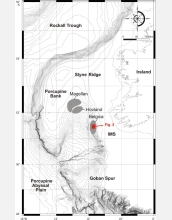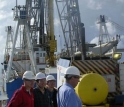News Release 05-065
Ireland Joins International Marine Research Program
Scientific drillship readies for expedition in Irish waters
April 27, 2005
This material is available primarily for archival purposes. Telephone numbers or other contact information may be out of date; please see current contact information at media contacts.
Ireland's Minister for Communications, Marine and Natural Resources, Noel Dempsey, today visited the JOIDES Resolution, one of the largest research vessels in the world, to announce Ireland's participation in the Integrated Ocean Drilling Program (IODP).
IODP is an international marine research drilling program that advances scientific understanding of the Earth by monitoring, sampling, and monitoring sub-seafloor environments. IODP scientists explore the deep biosphere, environmental change and solid earth cycles.
Dempsey welcomed the JOIDES Resolution to Ireland, saying its presence speaks of "a prestigious international geoscience exploration program, and marks Ireland's growing reputation for sophisticated geoscience capability." Aboard the drillship, Dempsey announced Ireland's affiliation to IODP through the Geological Survey of Ireland (GSI).
"Ireland was an important participant in the Ocean Drilling Program, IODP's predecessor," said Bruce Malfait, head of the marine geosciences section at the U.S. National Science Foundation (NSF). "We welcome Irish scientists into this new phase of international cooperation in the exploration of our planet and its oceans."
Ireland joins the European Consortium for Ocean Research Drilling (ECORD), a contributing member of the program primarily supported by NSF and Japan’s Ministry of Education, Culture, Sports, Science and Technology, in supporting IODP. The JOIDES Resolution was docked in Dublin Port for the first time in preparation for sub-seafloor research on what are called the Porcupine Basin Carbonate Mounds.
"Ireland is well placed," observed Dempsey, "to join the international team of scientists on this voyage. Substantial investments are now a regular feature of Ireland's geoscience programs, attracting many scientists from abroad who are aware of the programs' international caliber."
Samples recovered by IODP will address how the carbonate mounds originated on the ocean floor and whether bacteria play a major role in building the mounds. Samples also will provide information about how mounds relate to cold- and deep-water coral and sponge reef development, and give clues about past regional climates.
IODP scientist Jean-Pierre Henriet of Ghent University described the expedition: "Layer by layer, we will 'decrypt' the story of Ireland's deep-water mound ecosystems. Drilling into the layers of a mound is like reading the pages of a book."
According to GSI director Peadar McArdle, "The expedition will shed significant light on the evolution of Ireland's carbonate mounds and, in addition, the possible role of gas seeps in the development of these features."
Giant carbonate mud mounds like the Porcupine Mounds, some more than 300 meters high, have been discovered in recent years off the continental margins of Europe. The mounds are accumulations of sediment that usually occur in localized clusters and vary in size and shape; some are conical, some ridge-like or ring-shaped, and some steep-sided.
The Porcupine Basin mounds are up to two kilometers long and 350 meters high. Seismic profiles there also have revealed buried mounds some 50 to 100 meters high and covered with tens of meters of sediment.
Deep-sea surveys completed in the past few years suggest that Porcupine Basin may be among the most prolific areas for the formation of carbonate mounds in the world. New discoveries include a huge cluster of deep-sea reefs on hundreds of buried mounds off southwest Ireland.
-NSF-
-
Scientists drill into ocean crust from aboard the vessel JOIDES Resolution
Credit and Larger Version
Media Contacts
Cheryl L. Dybas, NSF, (703) 292-7734, email: cdybas@nsf.gov
The U.S. National Science Foundation propels the nation forward by advancing fundamental research in all fields of science and engineering. NSF supports research and people by providing facilities, instruments and funding to support their ingenuity and sustain the U.S. as a global leader in research and innovation. With a fiscal year 2023 budget of $9.5 billion, NSF funds reach all 50 states through grants to nearly 2,000 colleges, universities and institutions. Each year, NSF receives more than 40,000 competitive proposals and makes about 11,000 new awards. Those awards include support for cooperative research with industry, Arctic and Antarctic research and operations, and U.S. participation in international scientific efforts.
Connect with us online
NSF website: nsf.gov
NSF News: nsf.gov/news
For News Media: nsf.gov/news/newsroom
Statistics: nsf.gov/statistics/
Awards database: nsf.gov/awardsearch/
Follow us on social
Twitter: twitter.com/NSF
Facebook: facebook.com/US.NSF
Instagram: instagram.com/nsfgov


